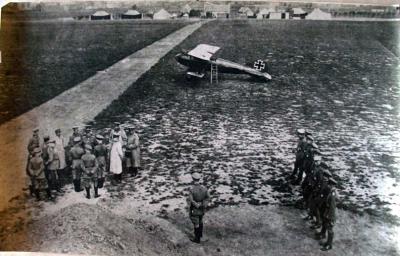The German aviator Manfred von Richthofen (1892-1918), also known as the Red Baron, was the commander of a World War I squadron dubbed The Flying Circus. Together, they shot down eighty-nine British airplanes from 1916 to 1917, when Richthofen was finally wounded. This 1917 photograph shows Richthofen receiving a medal from Paul von Hindenburg, while Erich Ludendorff watches. His red Albatros D.III is seen in the background.
The following is a portion of Richthofen’s book Der Rote Kampfflieger, from the English language version translated by J. Ellis Barker and published in 1918 under the name The Red Battle Flyer.
I Am Shot Down. (Middle of March, 1917)
I was flying with the squadron and noticed an opponent who also was flying in a squadron. It happened above the German artillery position in the neighborhood of Lens. I had to fly quite a distance to get there. It tickles one’s nerves to fly towards the enemy, especially when one can see him from a long distance and when several minutes must elapse before one can start fighting… We Germans had five machines. Our opponents were three times as numerous. The English flew about like midges. It is not easy to disperse a swarm of machines which fly together in good order. It is impossible for a single machine to do it. It is extremely difficult for several aeroplanes, particularly if the difference in number is as great as it was in this case. However, one feels such a superiority over the enemy that one does not doubt of success for a moment.
I watched whether one of the fellows would hurriedly take leave of his colleagues. There! One of them is stupid enough to depart alone. I can reach him and I say to myself, “That man is lost.” Shouting aloud, I am after him. I have come up to him or at least am getting very near him. He starts shooting prematurely, which shows that he is nervous. So I say to myself, “Go on shooting. You won’t hit me.” He shot with a kind of ammunition which ignites. So I could see his shots passing me. I felt as if I were sitting in front of a gigantic watering pot. The sensation was not pleasant… But suddenly I heard a tremendous bang, when I had scarcely fired ten cartridges. Presently again something hit my machine. It became clear to me that I had been hit or rather my machine… I went right down.
Instinctively I switched off the engine and indeed it was high time to do this. When a pilot’s benzine tank has been perforated, and when the infernal liquid is squirting around his legs, the danger of fire is very great. In front is an explosion engine of more than 150 h. p. which is red hot. If a single drop of benzine should fall on it the whole machine would be in flames. I left in the air a thin white cloud. I knew its meaning from my enemies. Its appearance is the first sign of a coming explosion. I was at an altitude of nine thousand feet and had to travel a long distance to get down.
This photograph was gift from Dr. Paul Van Dyke (1859-1933) class of 1881 and professor of Modern European History. He also donated a album of photographs taken by Lt. Edward C. Olds, class of 1909, during World War I. Manuscripts collection MSS CI199 (no.803).

Please note that the airplane in the background is an Albatros D.III, not a Fokker Dr. I triplane.
The Baron's name is spelled differently in the title and the body of the article.